It is a widely accepted shibboleth, appearing in practically every barbecue book ever written: “If you’re lookin’, you ain’t cookin'”. The message is that when you open the lid of your grill or smoker, cooking slows or stops and each furtive look adds lots of time to the length of the cook.
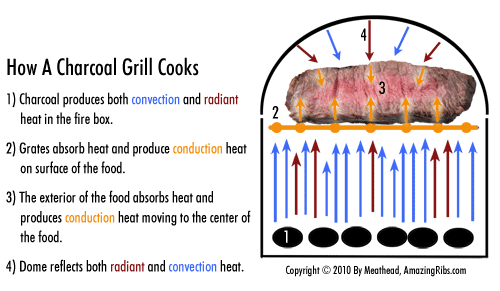
That’s because, with the lid on, heat works on the food from above as well as below. Take the lid off, all the hot air escapes and the food cooks from below only.
Well, there are times when you want to cook on one side only but most of the time it is better to cook on both sides. In general, you want to cook thin foods on one side at a time so the bottom surface can brown but heat will not penetrate from above. Then, when you flip, you can brown the other side and not risk overcooking it. In other words, some things cook better in a frying pan and some things cook better in the oven, and a grill with the lid on is just an outdoor oven.
Know-it-alls like this Meathead have often stated that if you open the lid on a smoker that is cooking low and slow ribs or something like that, you add 15 minutes to the cooking time. The logic is that heat and humidity escape, cold dry air replaces them, and if you are using charcoal or wood, oxygen swoops in and feeds the fire and knocks the equilibrium you worked so hard to establish all out of whack. Worse still, I believed, humidity evaporating from the meat or a water pan would escape and you’d end up with drier meat. The warning against lookin’ is meant as a caution to cooks who are constantly basting their food or just admiring their handiwork.
That makes sense, right? But logic isn’t enough for the AmazingRibs.com science advisor Prof. Greg Blonder. Armed with a stopwatch and a thermocouple thermometer with four probes, he set out to test the theory on his gas grill, his pellet smoker, and his charcoal grill in summer and again in winter.
Lookin’ inside a gas grill
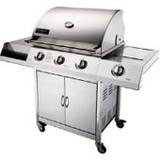
So one fine October day, with the ambient air temp in the 70s, Blonder cranked his Charmglow three burner standard gas grill to high and after a while, it settled in just north of 475°F near the center of the cooking grate about 2″ above the surface.
Then he opened the lid for one minute. Boom! The air temp dove to about 150°F. When he closed the lid, it climbed almost all the way back in a minute or two. “No harm, no foul,” says Blonder.
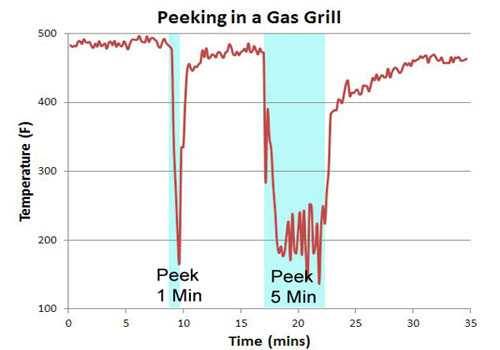
Then he opened it for five minutes. The temp dove to around 200°F rapidly and stayed there while the lid was up. When he closed the lid it got back up to 400°F pretty quickly but it took almost 10 minutes to level off at more than 450°F and another 10 minutes to get back up to 475°F.
When the lid is opened for only a minute, some of the hot air remains trapped under the lid, the metal in the lid remains hot, and the metal grates on the cooking surface don’t have a chance to cool off. But when it is opened for five minutes, the hot air trapped under the lid bleeds off, ambient air infiltrates, the lid gets cool, and the cooking grates drop in temp. Once the metal has cooled off, it takes time to heat it back up. He explains “The reason it takes so long to reheat is the gas grill, unlike a kitchen oven, has no temperature sensor or feedback. Unaware the temperature has dropped, it doesn’t increase the gas flame in response.”
Lookin’ inside a pellet smoker
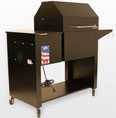
Then he rolled out his MAK 1 Star pellet smoker, set it for 200°F, and tossed in a five-pound pork butt. He set a probe in the center of the meat, another 1/2″ below the surface, and another about 2″ above the cooking surface near the meat.
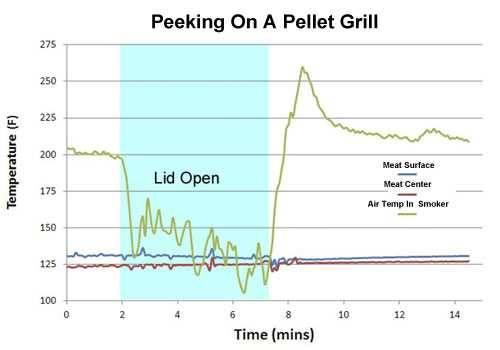
A one-minute peek was nearly invisible (the chart for that is not shown). But when he opened it for five minutes, the air temp quickly dropped and bottomed out at just over 100°F (the green line in the chart). But most pellet smokers have thermostat control like your indoor oven, “a negative feedback circuit” in physicists speak. As a result, it burned more pellets and pushed more air to the fire pot so the recovery was rapid, about 2 minutes, in fact, 1/5 the time it took for the gas grill to recover. In fact, it overshot the mark by more than 50°F and then settled into the target temp.
But here’s the most interesting data: The probe placed near the meat’s surface dropped only about 3°F (the blue line), and another probe in the center of the meat (red line) continued to climb pretty steadily despite the cooling of the grill, warmed not by the air, but by heat transferred inward from the warm meat on the outside.
Click here for more info on how these clever new pellet cookers work.
Lookin’ inside a charcoal grill

Finally, Blonder took out his Weber Kettle and fired it up. With hot coals and a chicken on board, it hit close to 450°F in a hurry. Again he opened the lid for one minute. Boom. Down to 150°F almost instantly. He put the lid back on and the temp recovered in about two minutes to about 400°F.
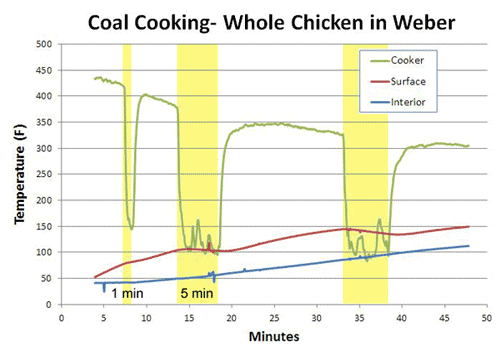
When he took the lid off for five minutes the temperature bounced back fairly quickly, but never got higher than 350°F, because, even with the lid on, as the coals burn down, the temperature in a charcoal grill slowly declines.
The lesson is that the effect of opening the lid on a charcoal grill like the Weber Kettle is greater than on gas or pellets because the heating potential of charcoal is limited. It eventually diminishes and burns out. So you are not only losing cooking time, you are losing cooking time at a higher temp.
What about the chicken? As with the pork on the pellet grill, the meat responded to the opening of the grill, but only near the surface, and only slightly. The center barely blipped.
Heavy-duty grills and smokers

Alas, neither Blonder nor I own one of those big sofa-sized heavy-duty rigs that competition cooks use (that’s one of the top competitors, Johnny Trigg with his Jambo cooker below).

Some of these professional cookers are made from steel 1/8 to 1/4″ thick, and all that iron really absorbs the heat. There are also cookers that have double walls, and insulation, and some are built of thick ceramic materials to help retain heat. It takes a long time for those babies to heat up and cool off. So Blonder built a simulator. He took two aluminum plates 12″ wide x 12″ long by 1/2″ thick and connected them so they were 1.75″ apart.
He put his metal plate sandwich in the center of his gas grill. He turned on the left and right burners and set them for medium, but left the middle burner off so there was no heat directly below them. He put one digital probe above the sandwich near the lid, and another floating in the center of the sandwich. The first thing you notice is that the probe near the dome is 100°F hotter than the probe in the plate. That’s because heat often builds up under the dome and is often much hotter than down where the food is. “Yet another reason to ignore the built-in dial thermometer,” says Blonder. Anyone who reads this site knows this is a crusade I have been on for years.
When the temp stabilized he opened the lid for five minutes. The temp in the dome and the center of the two hot plates dove to around 100°F as it did in the other cookers, and when he closed the lid it recovered quickly, pretty much the same as the others. Yes, the thermal mass made the drop shorter and recovery faster, but as we saw above, the recovery is pretty fast on most cookers.
The big rigs will reduce temperature spikes and recover more quickly than backyard grills because they have so much thermal energy stored up in their significant mass. But they still drop because air is a lousy heat conductor.
Indoor ovens
Blonder also tested the recovery in an indoor oven and since he likes busting myths, he tried putting a pizza stone inside to see if the oft-repeated theory that it will stabilize temps is true. Same results. The rapid drop in temp when the door is opened, rapid rise when closed. And the pizza stone made little difference.
Cold weather
Blonder repeated his test with a four-pound pork butt on a gas grill on a day in February when the air was 18°F and the wind only 10 mph.
Even in winter, peeking for only a minute had practically no impact. The air temp recovered in 2 to 3 minutes, while the meat’s surface only declined 5°F. The interior of the meat didn’t even flinch.
But when he left the lid up for five minutes in a winter wind the grill took 15 to 20 minutes to return to a steady state. But the meat’s surface dropped 20°F, and although the interior did slow down its rise a bit, it continued to cook.
As we might expect, the cold weather made peeking a bit worse than in the summer, but not drastically.
Says Blonder: “Air temp is less important than wind.”
Conclusion: Another myth busted
So is it true that “If you’re lookin’ you ain’t cookin'”? No, it is not true in warm weather if you open and close quickly and don’t do it often. Yes, it is true if you leave the lid off for long or if you open it frequently, especially in cold weather.
To be sure, the air temp in the cooker drops precipitously, but as we have seen, it also recovers quickly. If you peek for one minute an hour, and the temp drops from 225°F to 100°F for two minutes, the average temp the meat feels is 221°F. Here’s the formula:
(225*58 + 100*2)/60 = 221
This is a drop of less than 2% and in theory that could add about 12 minutes to a 10-hour pork shoulder cook if you open the lid for one minute every hour on a cooker that doesn’t have a thermostat.
If you peek for five minutes an hour, and the temp drops from 225°F to 100°F for seven minutes (keep in mind the temp ramps up and down), the average temp the meat feels is 210°F. Here’s the formula:
(225*53 + 100*7)/60 = 210
This is a drop in temp of about 8% and that could add 48 minutes to a 10-hour pork shoulder cook if you open the lid for five minutes every hour on a cooker that doesn’t have a thermostat.
However, if you have a thermostat cooker like the MAK which overshoots to compensate for drops in temp, there may be no delay in finish time at all.
But the most salient data is not the air temp in the cooker. It is the temp in the center of the meat. Blonder’s data shows that the incursion of ambient air doesn’t seem to have any measurable impact on the center of the meat. That’s because meat is almost all water and fat (a typical average for a pork butt might be about 65% water, 15% fat). Both are great insulators, and a quick peek under the hood isn’t going to drain heat from the meat much more than opening the fridge to take out the milk would warm the meat stored within. Even with the lid open heat continues to work its way toward the center of the meat by conduction. This is even more true the thicker the meat. Warm molecules inside the meat are moving faster than cool ones, and when they jostle the cooler ones they move faster and warm up. The surface of the food may cool momentarily, but the mass of the meat has a lot of thermal energy stored up, especially the longer into the cook you go, and so it keeps on cookin’ regardless of your lookin’.
This, by the way, is the same phenomenon seen when you take a roast or a turkey out of an oven or grill. Called “carryover” the hotter parts of the meat warm the cooler parts in an effort to reach thermal equilibrium. As a result, when you take a piece of meat out of the cooker, the temp in the coolest part of the center can rise as much as 5°F. In this case, the meat is still in the cooker, but the hot parts continue to warm the cool parts even though the air in the cooker has dropped to 100°F.
In practice, this residual heat in the thermal mass of the meat may reduce or even negate the loss of cooker temp. We have asked a friend with several thermostat-controlled MAK pellet smokers to run this experiment. Stay tuned.
There is another factor that permits you to peek. If you are doing a long low and slow cook and you open the hood when the meat is in “The Stall” phase of cooking, when the temp does not rise much at all because evaporation of moisture is cooling the meat, Blonder estimates the impact will be even less.
What about the moisture? Blonder did not test for that in this series of experiments. A lot of low and slow smokers use water pans to add moisture to the atmosphere and I among many others have always feared that opening the cooker would mess up the relative humidity of the atmosphere inside the cooker. But the more I think about it, that just doesn’t make sense. Moisture in a cooker is not confined to the cooking chamber because they are not airtight. Far from it. Much of the moisture goes right up the chimney and out the sides, so opening the cooker for a few minutes won’t mess up the humidity much. I asked Blonder what he thought and he said “There is much less humidity in a cooker than people think. Besides, most gas grills and pellet smokers change out the entire air volume more than 100 times an hour. In a really tight cooker with the vents mostly closed it’s more like five times an hour. So looking for a minute just won’t affect the humidity.”
Obviously, if you open the cooker too often the average cooking temp will drop, the exterior of the food will cool significantly and which will slow the cook slightly by absorbing the thermal energy within the meat, but the drop in surface temp is small and recovery will be fast. The amount of energy used should not impact the length of the cook significantly.
How often is too often? Hard to say, but let’s leave it at this: Don’t peek more than you have to, and if you have to peek make it quick, but if you feel the need to turn your meat, to baste, spritz, sprinkle with fairy dust and make incantations, go for it. The advantages of moving meat from the hot side to the cool side, checking to make sure nothing is burning, far outweigh the small heat loss. And if you have repeated the catchphrase “If you’re lookin’, you ain’t cookin'” it’s time to stop.
How important is constant temp?
Every pitmaster will tell you that it is crucial to keep your pit temp steady. Is it?
Holding a constant temp seems desirable because it is a sign that you are in control, and it helps immensely with timing and predicting when the food will be ready, but does it make a difference to quality? I have never seen it proven, and I suspect it is not as important as they say.
Indoors, our ovens are controlled by a thermostat that turns the heat on, off, on, off, etc. The swings can be plus or minus 20°F but the average is close to the temp you set it for. Despite these ups and downs of as much as 40°F, kitchen ovens still put out great food. This fluctuation happens on pellet grills because they are also thermostat controlled, and on gas grills with gusts of wind, and any other grill or pit when you open the lid.
Remember, meat is mostly water and water responds slowly to temp changes. Think of how long it takes to make water boil. At low cooking temps, the water in meat responds very slowly. That’s why it takes 5 to 6 hours to cook spare ribs at 225°F.
Here’s how the process works, the hot air cooks the outside of the meat. The outside of the meat cooks the inside of the meat. So the outside of the meat feels fluctuations in the air temp but is slow to respond because it is wet, and evaporation cools the surface. As long as it is wet, the surface temp cannot exceed 212°F. The inside of the meat is even slower to respond because it is not feeling the fluctuations directly. It is just feeling what is happening to the adjacent molecules. So the inside of the meat is not likely to notice temperature fluctuations in the cooker. Think about walking around on a cold day in a really good quality down coat. Your chest is like the inside of the meat and your face is like the surface of the meat. Your chest is insulated and warm, but your face is cold. The temp can drop 20°F and you’ll notice it on your face, but your chest can’t tell.
So I suspect that fluctuations in pit temp have minimal impact on the quality of the interior of the meat. How those fluctuations impact the crust or its flavor, we can only guess. Who knows, it might improve it!
An impertinent question for Weber and other gas grill manufacturers
Blonder’s work raises some more prickly questions.
Why do grill manufacturers continue to use crappy bi-metal dial thermometers in the digital age? And why do they place them in a location high above the food since the food we are cooking is several inches below? But a more important question is why aren’t they installing thermostats?

Indoor ovens have had thermostat controls since about 1915.
Wood pellet burning grill/smokers have had thermostats since they first appeared in the early 1990s and they are the hottest new category of grill with more than a dozen manufacturers appearing in the past five years. That’s the state-of-the-art MAK Grill thermostat at right, complete with programmable settings and three jacks for meat probes.
The BBQ Guru, a thermostat controller for charcoal grills that controls airflow to the coals first appeared in 2004, and there are two competitors now on the market, Rock’s Stoker and the iQue 110.
When in the name of iPhone will Weber or one of the other high-end grill builders put simple thermostats on gas grills? Most replacement thermostats for an indoor oven cost under $100 retail. Surely a major grill manufacturer could add a push-button control system just like your indoor oven for about $100. What’s the problem?
Meanwhile, if you own a gas or charcoal grill and don’t have a quality digital oven and meat thermometer yet, please read my article on thermometers and order one.
More on the subject
Here is a link to Blonder’s website with the test data on peeking into the three grills
Here’s the data on the metal plates and the indoor oven with the pizza stone
Here’s a link to my article on the equally fascinating research Dr. Blonder did on The Stall



High quality websites are expensive to run. If you help us, we’ll pay you back bigtime with an ad-free experience and a lot of freebies!
Millions come to AmazingRibs.com every month for high quality tested recipes, tips on technique, science, mythbusting, product reviews, and inspiration. But it is expensive to run a website with more than 2,000 pages and we don’t have a big corporate partner to subsidize us.
Our most important source of sustenance is people who join our Pitmaster Club. But please don’t think of it as a donation. Members get MANY great benefits. We block all third-party ads, we give members free ebooks, magazines, interviews, webinars, more recipes, a monthly sweepstakes with prizes worth up to $2,000, discounts on products, and best of all a community of like-minded cooks free of flame wars. Click below to see all the benefits, take a free 30 day trial, and help keep this site alive.
Post comments and questions below
1) Please try the search box at the top of every page before you ask for help.
2) Try to post your question to the appropriate page.
3) Tell us everything we need to know to help such as the type of cooker and thermometer. Dial thermometers are often off by as much as 50°F so if you are not using a good digital thermometer we probably can’t help you with time and temp questions. Please read this article about thermometers.
4) If you are a member of the Pitmaster Club, your comments login is probably different.
5) Posts with links in them may not appear immediately.
Moderators